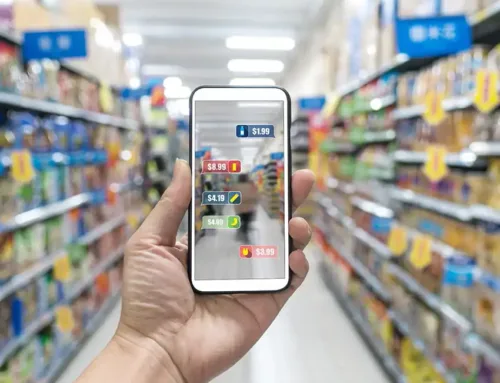Increasing Average Basket Size in Retail
Want to boost your sales without attracting new customers? Increasing average basket size is the way to go. This article will guide you through effective techniques like cross-selling, upselling, and product bundling to help you get the most out of each transaction. You'll find actionable tips that you can implement both in-store and online.
Key Takeaways
- The average basket size measures the number of items purchased per transaction, providing valuable insights into consumer behavior and informing tailored marketing strategies.
- Effective techniques for increasing average basket size include cross-selling, upselling, offering free shipping, and product bundling, all targeting different customer purchasing behaviors.
- Enhancing customer experience through personalized services, loyalty programs, and optimizing store layout can significantly boost average basket size and drive sales.
Understanding Average Basket Size
Average basket size refers to the typical number of items purchased per transaction. It differs from average order value, which tracks the total dollar amount spent per order. While both metrics are important, they serve distinct purposes. Average basket size provides insight into consumer preferences and buying behavior, enabling retailers to tailor marketing strategies, design effective promotions, and recommend relevant products that align with shopper interests.
Larger basket sizes indicate higher consumer spending, leading to increased revenue. This metric helps identify opportunities to optimize product offerings and inventory flow, supporting store growth and improving competitiveness. During economic downturns, boosting average basket size becomes critical for sustaining sales, especially when combined with big data insights and a clear understanding of retail dynamics.
Tracking this key metric reveals seasonal sales trends and supports smarter inventory planning. Understanding average basket size helps retailers identify high-value items and uncover purchasing patterns that inform better business decisions. It is vital in grocery performance analysis, where even small changes in units per basket can significantly affect profit margins.
Proven Techniques to Increase Average Basket Size
Several techniques can significantly boost average basket size and increase basket sizes, including:
- Cross-selling
- Upselling
- Offering free shipping
- Product bundling
Each strategy targets different aspects of customer behavior and purchasing patterns, encouraging shoppers to add more items to their baskets.
Cross-Selling and Upselling
Cross-selling recommends complementary products to customers, typically from different categories. For example, suggesting a laptop bag or an external mouse to a customer buying a laptop can lead to additional purchases of relevant products. This technique is effective when implemented through personalized suggestions by store associates or automated recommendations on e-commerce platforms. Additionally, businesses can enhance their strategies by focusing on how to cross-sell effectively.
Upselling encourages customers to buy a more expensive version of the product they initially considered by highlighting the benefits of a premium version. For instance, suggesting a model with better features to a customer buying a basic smartphone can result in more revenue. Combining cross-selling and upselling can significantly enhance the average basket size.
A frictionless checkout process is essential to ensure customers do not abandon their carts due to complexity. Placing items near the checkout area can encourage last-minute additional purchases. Apps that recommend products based on cart items further enhance the effectiveness of cross-selling and upselling strategies.
Offering Free Shipping
Free shipping is a powerful incentive for cost-conscious consumers. Offering free shipping on orders meeting a minimum purchase requirement encourages customers to add more items to their carts to qualify. This strategy increases average basket size and enhances customer satisfaction, as shoppers perceive greater value for their money.
Combining free shipping with other promotions, such as discounts or a gift for orders above a certain amount, can further entice customers. This multi-faceted approach leads to more sales and higher average basket sizes, benefiting both the retailer and the customer. Additionally, offering discounts with a percentage discount can enhance the appeal of these promotions.
Product Bundling
Product bundling involves offering related products together at a discounted price, creating a more attractive deal than buying each item individually. For example, a fitness retailer might bundle a yoga mat, a workout top, and a pair of workout bottoms as a set at a lower total price. This strategy simplifies the decision-making process for customers and increases the number of items sold per transaction.
Bundling complementary items gives customers more confidence in their purchases and saves time, leading to increased satisfaction and higher average basket sizes.
Product bundles can optimize inventory management by putting items together to move multiple items at once, enhancing overall sales and reducing stock issues. Strategically bundling items can drive up the average basket size while providing value to customers and helping to sell more effectively.
Enhancing Customer Experience
Improving the customer experience is a powerful way to increase average basket size. Personalized shopping appointments and loyalty programs can encourage customers to purchase more by offering tailored experiences and meaningful rewards.
Retailers focused on enhancing customer engagement often track related metrics, such as average transaction value, to gain insights into spending behaviors that drive overall store performance.
Personal Shopping Appointments
Personal shopping appointments offer one-on-one attention, allowing customers to receive tailored recommendations based on their preferences. This personalized experience can significantly increase the average basket size, as customers are more likely to consider additional items purchased when guided by a knowledgeable associate. For example, a simple purchase of a dress can turn into a complete outfit with accessories, enhancing the shopping experience through personalized offers.
These appointments allow customers to interact closely with products, increasing the likelihood of repeat purchases and fostering loyalty. By creating a more engaging shopping trip, retailers can convert simple transactions into more substantial sales.
Loyalty Programs
Loyalty programs encourage larger orders by offering rewards for spending. Paid loyalty programs, in particular, tend to be more effective in increasing basket size, as they provide members with substantial benefits such as points for purchases, exclusive discounts, free products, and personalized deals based on past shopping behavior.
These tailored promotions motivate customers to add recommended items to their baskets, ultimately increasing the average basket size. By aligning offers with individual preferences, personalized loyalty programs not only boost spending but also strengthen long-term customer loyalty.
Optimizing Store Layout
A well-designed store layout can significantly influence customer spending by encouraging exploration and increasing the likelihood of additional purchases. Placing high-demand items near the entrance captures immediate attention, while positioning high-margin products to the right of the entrance can drive higher revenue.
Wide, uncluttered aisles that are easy to navigate enhance the shopping experience, encouraging customers to spend more time in the store and ultimately increase their basket size.
Additionally, mobile point-of-sale devices streamline the checkout process, creating a smoother, more efficient experience for both customers and store associates.
Ensuring Inventory Accuracy
Accurate inventory records are crucial to avoid missed sales opportunities and ensure customer satisfaction. Out-of-stock items can lead to a loss of revenue due to fewer items in customer baskets. Accurate inventory management keeps stock updated, ensuring customers can purchase the items they desire.
Reducing stockouts and tracking inventory turnover ratios helps identify slow-moving products and make timely decisions on markdowns. Availability of recently returned items for purchase can also influence a customer's decision to increase their average basket size.
Leveraging Technology for Better Sales
Technology can significantly enhance sales by providing a seamless shopping experience. Omnichannel strategies and mobile POS systems are two critical tools that can help retailers boost their average basket size.
Integrating online and offline channels offers a more comprehensive shopping journey that encourages larger transactions.
Mobile POS Systems
Mobile POS systems offer several benefits:
- Facilitate quicker checkouts, encouraging customers to complete purchases faster and potentially add more items.
- Enable store associates to make customized recommendations and upsell products.
- Lead to higher impulse purchases and larger basket sizes.
Streamlining the checkout process with mobile POS systems creates a more efficient and enjoyable shopping experience, resulting in increased total transactions and overall sales.
Omnichannel Strategies
Omnichannel retail strategies enable customers to shop seamlessly across multiple platforms, enhancing both their experience and overall spending. By integrating online and offline channels, retailers make it easier for shoppers to combine purchases from various touchpoints, ultimately increasing average basket sizes.
A cohesive shopping experience not only encourages customers to buy more in a single transaction but also improves overall satisfaction, strengthening brand loyalty and boosting sales.
How to Calculate Average Basket Size
Calculating the average basket size is simple: divide total units sold by total transactions. For example, selling 1,000 small-ticket items across 200 transactions yields an average basket size of 5 items per transaction. This metric helps retailers understand purchasing patterns and adjust their strategies, ultimately impacting total sales, the average basket value, and the average ticket size.
To find the average basket size, divide the total number of items sold by the total number of transactions during a specific period. This is an essential part of understanding what is average basket size is and how it relates to broader store performance.
Measuring Success and Adjusting Strategies
Measuring the success of different strategies is crucial for determining their effectiveness in increasing average basket size. Data-driven store layout changes and A/B testing can identify configurations that maximize customer purchases.
Effective inventory management and continuous adjustments based on measured success ensure growth in average basket size over time. Retailers should also evaluate how to calculate average basket size in retail environments with high product turnover or promotional activity.
Summary
Increasing average basket size involves a multifaceted approach that includes understanding key metrics, employing proven techniques, enhancing customer experience, optimizing store layout, ensuring inventory accuracy, and leveraging technology. By implementing these strategies, retailers can drive substantial growth and enhance customer satisfaction.








